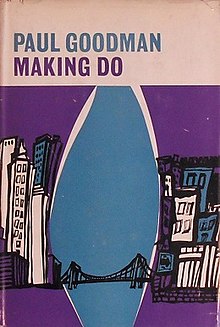 First edition | |
| Author | Paul Goodman |
|---|---|
| Published | November 1963 |
| Publisher | Macmillan |
| Pages | 276 |
| OCLC | 284498 |
| LC Class | PS3513 O53 M3 |
Making Do is a 1963 novel written by Paul Goodman and published by Macmillan.
 First edition | |
| Author | Paul Goodman |
|---|---|
| Published | November 1963 |
| Publisher | Macmillan |
| Pages | 276 |
| OCLC | 284498 |
| LC Class | PS3513 O53 M3 |
Making Do is a 1963 novel written by Paul Goodman and published by Macmillan.
The "Banning the Cars from New York" chapter begins with a spontaneous youth handball game played on the wall of a store. When its owner calls the police to end the game, the boy chastizes the narrator for not intervening, for "betraying natural society".[1] The narrator emotionally navigates the conversation and later that evening speaks on a metropolitan radio broadcast about social issues and transportation, proposing how private automobiles could be banned and the streets could be reclaimed for leisure.[2]

The Macmillan Company first printed Making Do in November 1963. A paperback edition followed in October 1964 with New American Library's Signet imprint.[3] The book incorporated previous works by Goodman, such as his 1961 proposal for banning cars from Manhattan[4] and two short stories: "Eagle's Bridge: The Death of a Dog" (1962)[5] and "At the Lawyer's" (1963).[6]
Goodman referred to Making Do, along with Parents' Day and The Break-Up of Our Camp as his three "community novels".[7] The work is autobiographical fiction with its central character as a middle-aged social critic, i.e., Goodman.[8]
Theodore Roszak wrote that the "Banning the Cars from New York" chapter encapsulated Goodman's ethos in building from spontaneous human joy into addressing a structural civic issue. It begins with Goodman's emphasis on unperturbed animal impulse, such as child's play or the narrator's physical love for the boy, and extrapolates into a larger societal concern and analysis.[8]
Goodman's fictional works received little critical recognition, according to a bibliographer of his works.[7]
The New York Times described Making Do as "a poor novel and a very interesting book" and that despite the narrator's similarity with the author, the narrator becomes a "bore".[9]